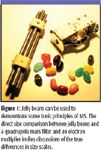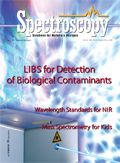Jelly Beans and Mass Spectrometry for K-4 Students
In this month's installment, columnist Ken Busch presents an elementary explanation of mass spectrometry that is appropriate for a young student audience, or for, perhaps just explaining to family what you actually do for a living.

Gas chromatography–mass spectrometry (GC–MS) is an example of a "complicated" analytical method that nevertheless can be explained in simple terms and in a short time. GC–MS is known to the mature general public in venues such as forensic and environmental analyses, and even to younger children through multiple shows on television (even cartoons touch on analytical instrumentation). GC–MS instruments themselves are small and not overly expensive, and the data produced, while sophisticated, still can be displayed and manipulated by a personal computer in a manner most folks can understand. The single topic of GC–MS and how it is used actually can fill a series of talks and demonstrations. But even within a single presentation, the basis of GC–MS can be highlighted. At the end of 20 minutes, the kids in my third-grade class understood the concepts of the chromatographic separation, the measurement of mass, and the principles of fragmentation as a structural fingerprint. The teacher, a bit more old-school perhaps, wondered why I, as a chemist, did not bring beakers and test tubes as part of my demonstration. I retreated quickly once the kids began chanting "GC–MS" as part of a catchy limerick about what to ask for at Christmas. The students in that class are just now graduating from high school, and I hope a few of them developed a spark for science.

Kenneth L. Busch
This column discusses some simple analogies to describe GC–MS to an elementary-school student audience. The analogies used can be made more sophisticated for an older group of school students, or for audiences of senior citizens. Remember that a detailed and technically correct explanation might seem more satisfying to you as a scientist, but your audience will remember simple, direct analogies and your skill in linking them to the points you are trying to explain. If you have similar experiences to share, I look forward to hearing from you. The contact information is in the biography at the end of the column. I divide the "GC–MS" explanation into four parts, the latter three of which are the mass spectrometer instrument itself. The section on the gas chromatograph can, with appropriate changes, be applied to most any chromatographic separation. Similarly, the MS analogies can be extended (with some modifications) to most mass spectrometers, and not just GC–MS instruments. I admit to some difficulty in putting together an elementary analogy for Fourier-transform MS (FT-MS); I hope to use a sound effect to demonstrate different frequencies of different ion masses trapped in the cell.
Gas Chromatography
The basis of a GC separation is a differential interaction of mixture components with the stationary phase of the column. Because there is a physical transport and a time involved, the differential interaction shows up as an elution time difference. The GC analogy is fairly easy to set up in a classroom setting. For elementary-school students, I use a cafeteria-line analogy. For older folks, I use a wedding receiving line to outline the situation. With the former, create a cafeteria food line in the classroom by rearranging chairs and recruiting three volunteers — call them Curly, Larry, and Moe. Each volunteer has a different behavior, which you explain clearly to the classroom, and which is rooted in jelly bean selection. Curly is hungry and stops at each station in the cafeteria line for only the time needed to grab some jelly beans — any jelly beans. Larry only likes red and pink and orange jelly beans, so he has to spend more time at each station to get only the jelly beans he likes. Moe is the picky eater and spends a long time at each stop trying to find the blue jelly beans, which are the only ones that he will eat. Start all three volunteers at the same time, encourage them to stay true to behavior, and the differential partitioning process becomes clear. The students are immediately able to determine the order of elution time as Curly, Larry, and then Moe. You can even repeat the "play" to show how retention times, given a constant set of behaviors and number of stations, remain the same, and even with more or less stations, in the same order. If the class is a bit more sophisticated, you can change the behaviors by "offering" different foods at the stops; this is the equivalent of a different stationary phase. You can then explain the reasons for subsequently different values and different orderings of retention times. The analogy to different food offerings in the cafeteria line (of more or less attractiveness to the students) is a rationale for chemical selectivity of different stationary phases.
The students will remember the science because the analogy is simple, valid, and straightforward. They will be eager to participate because — well, because the analogy involves food (it's a bribe, I admit). My demonstration bag is packed with jelly beans of different sizes and colors. Different color jelly beans represent the food that elicits different behaviors of Curly, Larry, and Moe — who demonstrate different fondness for the various flavors. And once your volunteers have worked through your first aliquot of jelly beans, you have the attention of the class to segue into some elementary concepts of MS. With jelly beans, of course.
MS — Ionization
Elementary-school students seem to have a basic idea of atomic structure, possibly from cartoons. ("Captain Proton" searched on Google provides links to both classic and modern science fiction escapades.) A web search also reveals many suggested elementary-school level demonstrations of atomic structure, using atomic particle surrogates of colored marshmallows, clay, or jelly beans. Jelly beans, in different colors and different sizes, will be used in each of the three different parts of the MS demonstration, and a polite guest lecturer leaves an ample supply in the classroom so that the students recall your demonstration for the next few weeks. NASA suggests using jelly beans and chocolates and raisins for the different atomic particles (1), and Matthew Besman describes an "edible atom lab" (2). Interestingly, the use of jelly beans to model atomic structure and reactivity extends through Grade 12, as described in state of Ohio standards (3).
Explain to the students that, for purposes of simplicity, atoms will substitute for more complicated molecules that represent the compounds eluted from the gas chromatograph. They will grasp that molecules are collections of atoms, and atoms are collections of subatomic particles. Set up and explain an atomic-particle scheme, such as big black jelly beans for neutrons, big blue jelly beans for protons, and smaller white jelly beans for electrons. Choose your own easy-to-see colors, but remember that some students might be color-blind to red. (How many mass spectrometrists remember that Dalton was color-blind, did research in this field (4), and that an early term for color-blindness was Daltonism?) If you can prepare ahead of time, you can string white jelly beans along a nylon fishing line, and depending upon your dexterity, you might actually venture to show electrons in orbit around a jelly-beans-in-your-hand nucleus! Choose your student volunteers to assemble their own several-different-jelly-bean nuclei to match the number of electrons you pre-prepared on white jelly bean strings. The salient points are the presence of the protons and neutrons together in the nucleus, the balanced numbers of protons and electrons in the neutral atom, and the proclaimed lack of interaction of a "balanced" proton–electron atom with external forces such as a magnetic or an electric field. These main issues suffice to introduce the concept of atomic structure, and then ionization. If you have time (and the class has interest), the concept of isotopes can be introduced with the use of a different number of black jelly beans (neutrons).
This simple demonstration works best for electron ionization of atoms; molecular ionization involves an ensemble of jelly bean atoms that is more difficult to assemble and explain. Protonation (such as occurs in chemical ionization) raises issues of chemical bonding that surpass most elementary student levels of understanding.
The third point listed earlier — that an atom with a balanced number of protons and electrons is indifferent (to an elementary approximation) to external forces such as a magnetic or an electric field — is crucial to the understanding of ionization. Introduce ionization as a process through which we put a handle on the atom so that we can move it around at will, and perform a mass analysis with electric or magnetic fields. Students might recall common demonstrations of magnetic field interactions that rely on classic metallic or nonmetallic items, showing a presence or absence of the attractive force. But this effect is based upon the magnetic properties of the material, rather than the relevant fact in mass spectrometry that the ion carries a charge. It is best to avoid the analogy based upon a correct but somewhat irrelevant underlying premise; concentrate on the charge!

Figure 1
How to achieve ionization in a jelly bean atom? Find a student group whose jelly bean atom has the same number of protons as the number of electrons on your chosen jelly bean string. Then, assemble a stable atom at the front of the class with you circling around the nuclear kids with your electrons on a string. Ionization is simple enough — blatantly eat an electron! A simple exercise then shows the students that there is an excess of protons now, and you can keep a tally on the board to show that the net charge on the atom is +1, corresponding to the charge on that extra unbalanced proton. If your compatriots want to eat the jelly bean nucleus, you can explain that such a reaction would fall into the realm of nuclear chemistry, and that is not what MS is all about.
Now we demonstrate the effect of an external force. In this case, we are going to recruit the teacher to represent an electric force (the accelerating potential). Inform the students that the teacher only exerts a force on ions — the atoms with an unbalanced number of protons and electrons in this case. Describe the teacher as a repulsive force (students smile and tend to agree with that assessment). Thus, as the teacher approaches an ion, the charged student-atom will be repelled. If that single electron had not been consumed, and the atom remained neutral, the teacher would have no effect. In this single part of a simple overall exercise, the demonstration has shown atomic structure, carried out a process of ionization, and then shown the principle through which an ion is physically transported from the ion source into the mass analyzer of the mass spectrometer.
MS — Mass Analysis
Add some sophistication to the analogy. Now, instead of subatomic particles, the jelly beans will represent atoms of elements, and different colored jelly beans are now different elements. Explain that each element has a different mass and that the mass analyzer in the mass spectrometer is the measuring tool so that we can tell the difference. Gather three students at the front of the classroom, because these are your new partners for a demonstration of mass analysis via a time-of-flight mass analyzer. Repeat that molecules are made of atoms, and because each different combination of elements has a different mass, so each jelly bean molecule that you assemble in each student's hand will have a different mass. The volunteer students might be prompted to admit that the mass of the jelly beans in their hands does not feel that different, regardless of whether they have five, eight, or 15 jelly beans grasped there. So ask the students to count out the jelly beans; then ask them to imagine that each jelly bean weighs about 100 lb, some a little bit less and some a little bit more.
Now a simple racetrack analogy serves to cement the concept of time-of-flight mass analysis for the students. Explain to each jelly bean–molecule student that they are about to run in a race with those several hundred pounds (some more, and some less) of jelly beans in their hands. Remind them, and get the remainder of the class to agree, that students with more mass will traverse your makeshift racecourse more slowly than the lighter-mass students. You adopt a position at the finish line, marking the finishing times of your jelly bean–molecule students at various times, and then explain the simple proportionality between mass and flight time. Then, you explain that just as the masses of real ions are orders of magnitude less than the jelly beans, or the students themselves, the flight times of the ions are orders of magnitudes faster than the race times you just measured in the classroom. But, with the right tools, we can measure these very short times and therefore measure the masses of the molecules as ions. When we know the masses of the molecules and how they fall apart (explain this by again examining the component parts of the jelly bean molecule), then we know something about what the molecule is!
MS — Ion Detection
In this last part of the explanation, the concept of scales must be explained. The key concept here is the concept of amplification accomplished with an electron multiplier; the students will recognize the term "multiplier," and preview the topic. And, using jelly beans again, the analogy will remain with them long after your visit to the classroom. Explain that jelly beans represented mass in the previous demonstrations, and now the jelly beans are going to represent charge. "Mass and charge," you explain, "are what mass spectrometry is all about!" You will need student volunteers again, this time, students assembled in three rows of four students each. (Note that by this time, you will have had the chance to involve almost every student in the classroom in some part of these demonstrations.) I bring three paper bags to class, with one, two, or three jelly beans inside. I explain that the jelly bean charge is so small that if one were to examine the bags, you would find it difficult to decide about the number of jelly beans inside. What's needed is a multiplication so that the jelly beans are forced to reveal themselves. So for each student in each of the three lines, you explain that they are to take whatever number of jelly beans they find in the bag as it is handed to them, add matching jelly beans one-for-one, and then pass the bag on to the next person behind them in line. Here are the sequences:
1:2:4:8:16
2:4:8:16:32
3:6:12:24:48
That last student in the third line has a lengthy counting task, and while that is accomplished, you explain the principles of multiplication in an electron multiplier, and how (holding up three bags now with obviously different numbers of jelly beans) multiplication makes it easier to detect small differences.
Finally, at the end of the demonstrations, you ask if you should gather up all your jelly beans and go home. Perhaps the jelly beans should stay in the classroom if the students can remember the principles of separation based upon different behaviors of Curly, Larry, and Moe. Do they remember the parts of the atom, and that a charge results when electrons and proton jelly beans are unbalanced, and that the repulsive force finds you once you become unbalanced? Do they remember that different jelly bean molecules also can represent molecules of different masses, that heavier masses move slower in a race, and that we can use a race to reveal differences in mass? Do the students remember that multiplication can make small things and small differences easier to detect? If they do, leave the bags of jelly beans, thank the teacher and the students, and remember that twenty years from now, these students might be in attendance at the ASMS annual meeting, searching for jelly beans in the hospitality suites.
Kenneth L. Busch convinced students of a third-grade class to loudly chant "GC–MS" during an explanation of MS, and recalls that the teacher was not amused. He is therefore reminded that it is important to preview and gather the insights of the teacher on the class presentation. He looks forward to the collection, preparation, and publication of a collection of elementary school demonstrations in the field of MS. This column represents the views of the author and not the National Science Foundation. The author can be reached at WyvernAssoc@yahoo.com
References
(1) http://www.nasaexplores.com/show_k4_teacher_st.php?id=04040593431
(2) http://www.lessonplanspage.com/ScienceEdibleAtomLab-ForPeriodicTableAtomsGoodIdea46.htm
(3) http://ims.ode.state.oh.us/ODE/IMS/Lessons/Content/CSC_LP_S03_BB_L12_I10_01.pdf
(4) J. Dalton, "Extraordinary Facts Relating to the Vision of Colours, with Observation," Mem. Literary Philos. Soc. Manchester 5, 28–45 (1798).

LIBS Illuminates the Hidden Health Risks of Indoor Welding and Soldering
April 23rd 2025A new dual-spectroscopy approach reveals real-time pollution threats in indoor workspaces. Chinese researchers have pioneered the use of laser-induced breakdown spectroscopy (LIBS) and aerosol mass spectrometry to uncover and monitor harmful heavy metal and dust emissions from soldering and welding in real-time. These complementary tools offer a fast, accurate means to evaluate air quality threats in industrial and indoor environments—where people spend most of their time.
NIR Spectroscopy Explored as Sustainable Approach to Detecting Bovine Mastitis
April 23rd 2025A new study published in Applied Food Research demonstrates that near-infrared spectroscopy (NIRS) can effectively detect subclinical bovine mastitis in milk, offering a fast, non-invasive method to guide targeted antibiotic treatment and support sustainable dairy practices.
Smarter Sensors, Cleaner Earth Using AI and IoT for Pollution Monitoring
April 22nd 2025A global research team has detailed how smart sensors, artificial intelligence (AI), machine learning, and Internet of Things (IoT) technologies are transforming the detection and management of environmental pollutants. Their comprehensive review highlights how spectroscopy and sensor networks are now key tools in real-time pollution tracking.